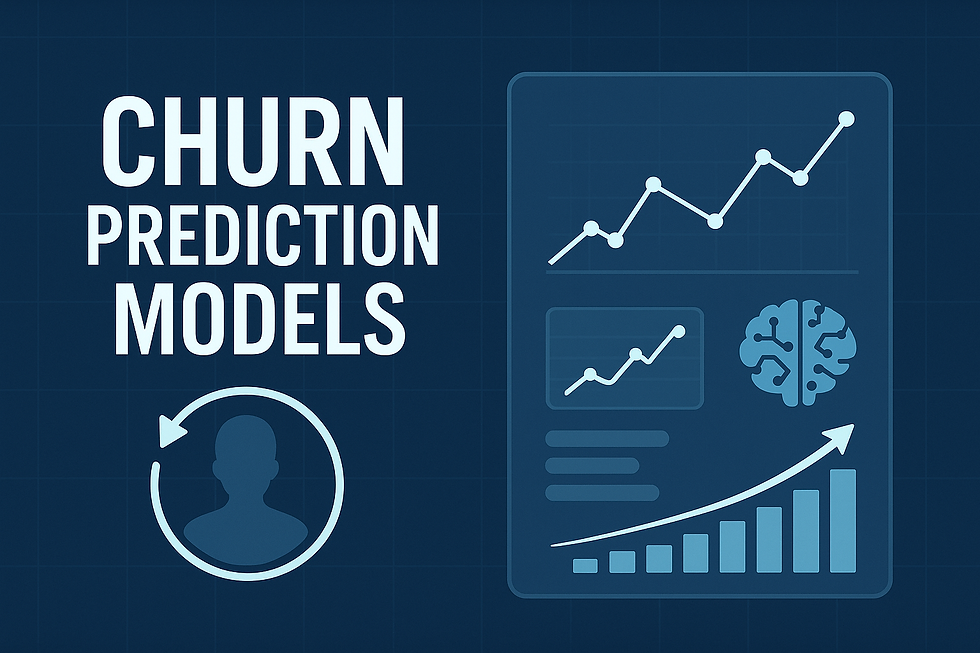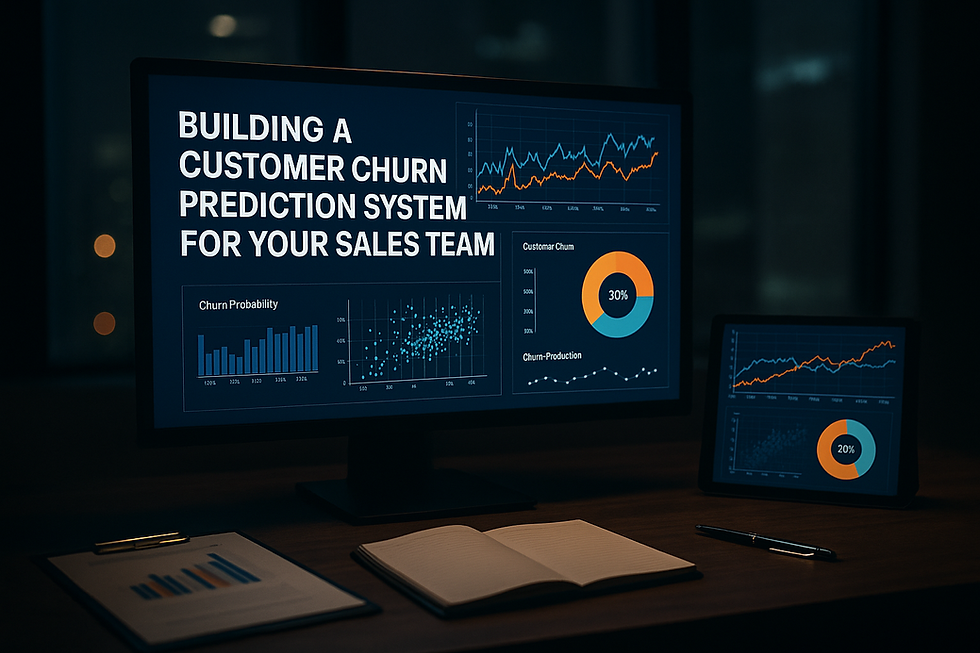Churn Prediction Models: A Complete Guide to Reducing Customer Attrition
- Muiz As-Siddeeqi

- Sep 16
- 5 min read

They came. They bought. And now—they’re gone.
That gut-wrenching feeling when a once-loyal customer quietly disappears? That’s churn. And it’s not just a sales problem. It’s a silent revenue killer. For SaaS businesses, e-commerce platforms, insurance providers, telecom giants, and even high-end gyms—churn means dollars leaking from your pipeline, often unnoticed, until it’s too late.
But what if you could predict who’s about to leave? Not with vague assumptions. Not with reactive calls. But with data. Machine learning is making this not just possible—but practical, scalable, and profitable.
This blog is your complete, no-nonsense, real-data-only guide to churn prediction models—what they are, how they work, what real businesses are doing, and how you can use them to cut customer attrition dramatically.
Bonus: Machine Learning in Sales: The Ultimate Guide to Transforming Revenue with Real-Time Intelligence
The Cold Truth About Customer Churn (And Why It’s Worse Than You Think)
Let’s not sugarcoat it. Customer churn is brutal.
According to a 2023 report by ProfitWell, SaaS companies lose an average of 5–7% of customers each month to involuntary churn alone (like failed payments).
HubSpot revealed in their 2024 Customer Experience Benchmark that 69% of churned users say they would have stayed—if someone had just shown them real value at the right time.
The Harvard Business Review published that acquiring a new customer costs 5 to 25 times more than retaining an existing one.
Gartner noted in a 2024 paper that reducing churn by just 5% can increase profits by 25% to 125% depending on the industry.
If churn is your enemy, churn prediction models are your radar system.
What Is a Churn Prediction Model? (No Buzzwords, Just the Real Stuff)
A churn prediction model is a machine learning model trained to identify customers who are likely to leave (cancel, stop purchasing, unsubscribe, switch providers, etc.).
It doesn’t guess. It learns from real historical data:
Past purchase behavior
Login frequency
Customer service interactions
Payment history
Survey responses
Product usage metrics
Once trained, the model predicts churn before it happens—giving you a chance to act.
Churn Isn't One Thing: The 5 Different Types You Must Know
One of the biggest mistakes we’ve seen companies make is treating churn as a single metric. It’s not. Here are the five real types of churn companies track and model for:
Voluntary Churn – The user leaves on purpose (cancels subscription, switches vendors).
Involuntary Churn – Payment failed, card expired, subscription canceled by system.
Partial Churn – The customer downgrades their plan or reduces spending.
Revenue Churn – The money lost through churn (not just number of customers).
Product Churn – When a user stops using a specific feature or product line.
Each one requires a slightly different prediction and prevention strategy—and yes, you can model each one with machine learning.
How Churn Prediction Models Work (Real Models, Not Theoretical Jargon)
Here’s how the magic happens—without any fluff.
1. Data Collection
You need labeled historical data. For example:
Customers who stayed = 0
Customers who churned = 1
Top features used in real-world models include:
Time since last login (Netflix, Spotify)
Number of support tickets opened (Zendesk)
Drop in email open rates (Klaviyo)
Time between purchases (Amazon Prime)
Usage of high-value features (HubSpot)
2. Data Preprocessing
Cleaning the data, handling missing values, encoding categorical variables, scaling features.
3. Feature Engineering
Recency, frequency, monetary value (RFM)
Seasonality (Does the customer churn more in Q4?)
Sentiment from support conversations (NLP-based)
4. Model Training
The most common models used in real churn prediction include:
Model | Real Companies Using It | Why It Works |
Logistic Regression | Salesforce | Transparent, interpretable |
Random Forest | Shopify, Amazon | Handles nonlinear relationships |
XGBoost | PayPal, Expedia | High performance, optimized for imbalance |
Neural Networks | Netflix | Captures complex behavior patterns |
Survival Analysis | Telcos (e.g. Vodafone) | Predicts when churn is likely |
5. Model Evaluation
Real metrics used:
Precision
Recall
ROC-AUC
F1 Score
Not just accuracy—because accuracy is misleading when churners are a small percentage.
Real-World Case Studies of Churn Prediction Models That Worked
1. Shopify
In 2023, Shopify implemented a churn prediction model for its merchants. Using XGBoost and behavioral metrics (like app uninstalls, ticket escalations, and drop in product listing updates), they achieved a 12% decrease in monthly churn within just 6 months of deployment. Their internal data science team presented this at the Re:Work AI in Business Summit 2024.
2. Zoom
Zoom adopted deep learning-based churn models during their post-COVID normalization phase. According to their Q1 2023 earnings call, their customer success team reduced churn by 18% among SMB users by proactively offering feature training to those flagged by the model.
3. Telstra (Australian Telecom Giant)
Telstra used survival models to predict when a customer might churn due to contract expiration. According to a 2022 McKinsey case study, they retained $400 million in at-risk accounts through predictive interventions.
4. Spotify
Spotify analyzes user engagement patterns and time-of-day listening behavior. According to a 2023 podcast by their engineering team, churn was reduced by 21% in premium users who received AI-personalized re-engagement emails.
What Data Do You Need to Build a Churn Prediction Model?
Here's what real companies collect (no guesswork):
Data Type | Example |
Behavioral | Logins, feature usage, session duration |
Transactional | Purchases, upgrades, payment delays |
Communication | Email opens, support tickets |
Demographic | Age, company size, job role |
Feedback | CSAT scores, NPS responses |
Time-series | Days since signup, monthly trends |
Pro Tip from real Kaggle competitions: The more behavioral and event-based data, the better your churn predictions.
Tools and Platforms Being Used Today (Not Hypothetical, Real)
HubSpot Service Hub + ML Plugins
Salesforce Einstein
ChurnZero
Mixpanel with ML integrations
Snowflake + Python (custom models)
Google Vertex AI
AWS SageMaker (used by PayPal)
According to the Gartner Hype Cycle for CRM 2024, churn prediction tools are in the "Slope of Enlightenment" phase—meaning they’re beyond hype and driving ROI for early adopters.
Why Your Churn Model Might Fail (Even If It’s Fancy)
Let’s be blunt. Many churn models fail because:
Bad data labeling (you’re marking the wrong users as churned)
Wrong business definitions (you defined churn as 30 days inactivity—but your users naturally come once every 45)
No follow-up action system (you predict churn, then… crickets?)
Overfitting on historical data
Ignoring seasonality and lifecycle stage
A churn model is only as good as the retention strategy tied to it.
What to Do After You Predict Churn
Prediction is the start. Action is the transformation.
Here’s what top companies are doing post-prediction:
Trigger hyper-personalized emails (Spotify, Amazon)
Assign CSM follow-up (Zoom, Salesforce)
Launch loyalty campaigns (Sephora)
Flag for human call intervention (Telstra, Comcast)
Dynamic discounts (Uber, DoorDash)
The best churn-fighting strategies combine machine intelligence with human empathy.
Real ROI: What’s the Business Impact of Predicting Churn?
Let’s talk numbers:
Netflix estimated that preventing 1% of churn equaled $125 million annually (per 2023 SEC filing)
HubSpot’s implementation of churn models saved $3 million in recurring revenue in 2023 (Source: HubSpot Blog)
Bain & Company found that increasing customer retention rates by 5% increases profits by 25% to 95%
No hype. Just hard financial wins from real prediction and action.
Final Word: Don’t Let Churn Be a Mystery—Let It Be a Model
Churn used to be mysterious.
Today, it’s a machine learning problem with a clear, proven, and profitable solution. Every customer who churns without warning is a signal your business failed to read. The models are here. The data is already in your systems. The ROI is already proven.
But only a few are using it right now. Will you be among them?

$50
Product Title
Product Details goes here with the simple product description and more information can be seen by clicking the see more button. Product Details goes here with the simple product description and more information can be seen by clicking the see more button

$50
Product Title
Product Details goes here with the simple product description and more information can be seen by clicking the see more button. Product Details goes here with the simple product description and more information can be seen by clicking the see more button.

$50
Product Title
Product Details goes here with the simple product description and more information can be seen by clicking the see more button. Product Details goes here with the simple product description and more information can be seen by clicking the see more button.






Comments